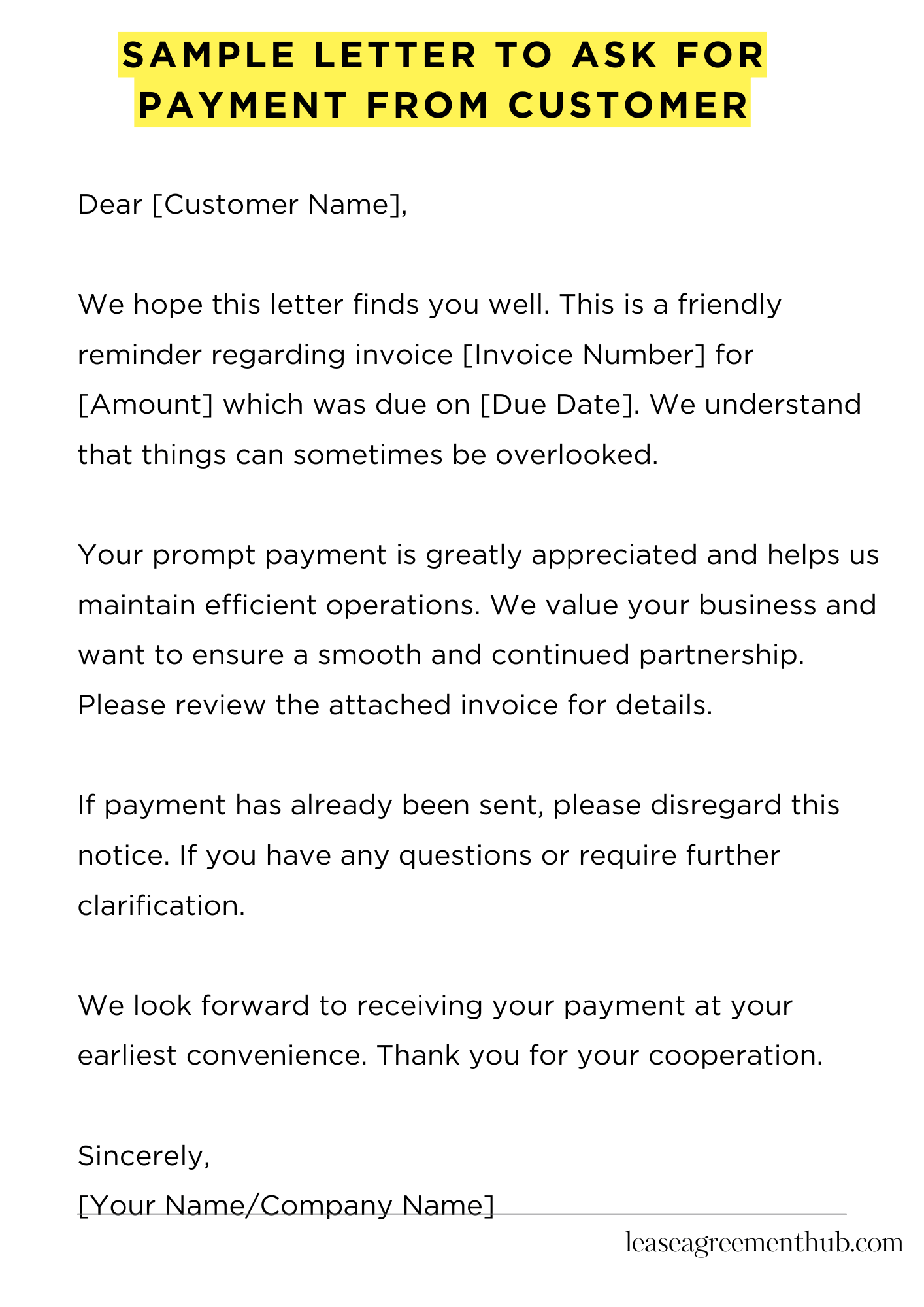A sample letter to ask for payment is a template. It helps you request overdue payments from customers. It keeps things professional and clear.
This article gives you examples. These are ready-to-use templates. You can adapt them to your needs.
We’ll provide various samples. These cover different situations. Use them to write your own effective payment request letters.
sample letter to ask for payment from customer
[Your Company Letterhead]
[Date]
[Customer Name]
[Customer Address]
Dear [Customer Name],
We hope this letter finds you well. This is a friendly reminder regarding invoice [Invoice Number] for [Amount] which was due on [Due Date]. We understand that things can sometimes be overlooked.
Your prompt payment is greatly appreciated and helps us maintain efficient operations. We value your business and want to ensure a smooth and continued partnership. Please review the attached invoice for details.
If payment has already been sent, please disregard this notice. If you have any questions or require further clarification, please don’t hesitate to contact us at [Phone Number] or reply to this email. We’re happy to assist you.
We look forward to receiving your payment at your earliest convenience. Thank you for your cooperation.
Sincerely,
[Your Name/Company Name]

How to Write a Sample Letter to Ask for Payment from a Customer
Understanding the Nuances of Delinquent Accounts
Successfully navigating the precarious terrain of overdue payments requires a delicate touch. A poorly worded demand can alienate a client, jeopardizing future business. Conversely, a professional and persuasive letter can expedite payment without damaging the relationship. This requires a nuanced approach.
Crafting a Salutation: More Than Just “Dear Sir/Madam”
The initial salutation sets the tone. Avoid generic greetings. Personalization is paramount. Use the client’s name, ideally addressing them by their preferred title (Mr., Ms., Dr., etc.). A formal yet friendly opening will establish a positive rapport. Begin with a statement demonstrating understanding and concern rather than immediate accusation – this is crucial for mitigating defensiveness.
Articulating the Owed Amount with Crystal Clarity
Ambiguity is the enemy. Clearly state the outstanding balance, referencing the invoice number(s) for impeccable traceability. Include the date(s) of invoice(s) and the due date(s). Present this information in a concise, easily digestible format, perhaps using a table for enhanced legibility and to avoid any potential obfuscation.
Employing Persuasive Language: The Art of Subtly Influencing
While firmness is necessary, avoid aggressive or threatening language. Frame your request in terms of mutual benefit. Highlight the value of your services and the importance of maintaining a positive business relationship. Subtle persuasiveness is far more effective than blunt demands. Employing strategically placed rhetorical devices can subtly influence the reader’s decision-making process.
Setting Realistic Payment Expectations and Deadlines
Propose a reasonable payment timeframe. Offer flexible payment options if viable, enhancing the likelihood of prompt settlement. This demonstrates a willingness to collaborate rather than simply issue a peremptory ultimatum. Clearly state the consequences of continued non-payment within the stated timeframe; but do so diplomatically.
Closing with Professionalism and a Call to Action
Conclude with a reiteration of your willingness to assist. Provide contact information for easy communication. End with a polite yet firm call to action, prompting the client to contact you to arrange payment. A professional closing reinforces the overall tone of the letter.
Sample Letter for Actionable Implementation
[Your Company Letterhead]
[Date]
Dear [Client Name],
We are writing to follow up on outstanding invoices [Invoice Number(s)] totaling $[Amount], which were due on [Due Date(s)]. We understand that unforeseen circumstances can sometimes cause delays, and we want to work with you to resolve this matter amicably.
Please find attached a copy of the invoice(s) for your review. We would appreciate it if you could remit payment within [Number] days. If you have already submitted payment, please disregard this notification. Should you require alternative payment arrangements, please do not hesitate to contact us at [Phone Number] or [Email Address].
We value your business and look forward to your prompt attention to this matter.
Sincerely,
[Your Name/Company Name]
FAQs about sample letter to asking for payment from customer
What information should be included in a payment request letter?
A payment request letter should clearly state the invoice number, the amount due, the date of the invoice, and the due date. It should also reiterate the services rendered or goods provided. Including contact information for both parties is crucial.
What is the best tone to use in a payment request letter?
Maintain a professional and courteous tone. While firm in your request for payment, avoid being aggressive or demanding. A polite and respectful approach is more likely to yield positive results.
When should I send a payment request letter?
Send the letter after the invoice due date has passed. Allow a reasonable grace period before sending the first request. Subsequent reminders can be sent at regular intervals, escalating the tone slightly with each communication if necessary.
How can I make my payment request letter more effective?
Use clear and concise language, avoiding jargon. Highlight the key information prominently. Consider including a brief summary of the outstanding balance and the consequences of non-payment, such as late fees or referral to collections.
What should I do if the customer doesn’t respond to my payment request letter?
If you don’t receive a response, follow up with a phone call or a second letter. Consider escalating the matter to a collections agency if necessary, but only after exhausting all other options and following any legally required procedures.
Related: